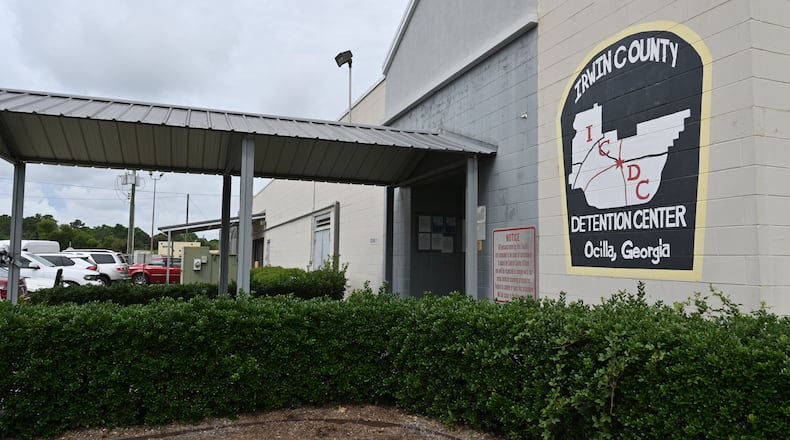As COVID-19 began spreading through a South Georgia immigration jail, one detainee fashioned a face mask from a sock. Another used a headphone cord to secure a plastic cup over his face.
Another man sat in front of a video-call camera and confided his growing fear. “I’m really scared,” he said, “I’m going to die.”
These are scenes from a new documentary called “The Facility,” directed by the journalist Seth Freed Wessler. The film uses the first months of the coronavirus pandemic to explore conditions at the Irwin County Detention Center in Ocilla, where undocumented immigrants were held, often indefinitely and without criminal charges, by the federal Immigration and Customs Enforcement agency.
“This is both a specific place and it’s also a story about a system,” Wessler, whose film debuts in early December on the documentary site fieldofvision.org, said in an interview. “We have a system that is treating asylum seekers and immigrants in a punitive way and is causing really significant suffering.”
Wessler, now a reporter for the online investigative news organization ProPublica, made the documentary after writing about the treatment of detainees at Irwin for HuffPost and The New York Times Magazine. The film begins in March 2020 as the first detainees tested positive for the coronavirus — and six months before a whistleblower went public with allegations that women detainees had been subjected to unwanted gynecological procedures.
The whistleblower, Dawn Wooten, a nurse, also said the facility was not following federal guidelines to contain the coronavirus, such as providing masks and instituting social-distancing protocols. Ultimately, 146 detainees at Irwin tested positive for the virus. (An executive with LaSalle Corrections, which runs the detention center, said the facility was “firmly committed to the health and welfare of our detained population.”)
Credit: Jenni Girtman
Credit: Jenni Girtman
The film unfolds mostly through interviews with detainees, which Wessler conducted over the detention center’s video-phone system. The footage from these calls includes ambient sound and video from the detention center’s common area. At one point, a detainee pointed out a passing guard who was unmasked. A television set played constantly in the background, often showing Spanish-language news programs. Wessler lingers on a campaign commercial in which former U.S. Sen. David Perdue extolled the “individual liberty for our children” that “the rest of the world envies.”
“I was starting to see what normal life (in the facility) looks like,” Wessler said. “Inside the cell block, people were seeing the same TV that I was.”
Much of the film centers on two detainees whose experiences at Irwin inspired them to become immigrant-rights activists.
Nilson Barahona-Marriaga, a native of Honduras, had been detained after he was charged with driving under the influence and faced the possibility of deportation.
“My father is a citizen,” he told Wessler. “My wife is a citizen. My son has been born here. My mom is a legal resident. I’ve been here almost 20 years. So what is the point of ICE having me here for?”
When Barahona helped lead a hunger strike to protest the lack of protections from COVID-19, guards placed him in an isolation cell for 14 days. Andrea Manrique, a Colombian national, received a similar punishment for leading protests by women detainees.
Manrique came to the United States on a tourist visa and told immigration agents she was seeking asylum because she feared violence in her home country.
“I thought this country was going to protect me,” she told Wessler.
Instead, she spent almost two years in detention, mostly at Irwin. Barahona was detained about eight months. ICE released both on the same day in November 2020, without explanation. Barahona has since applied for permanent resident status, and Manrique’s asylum application is pending. Both now advocate for other detainees seeking release.
Credit: TNS
Credit: TNS
Before Wessler completed the film, federal immigration officials canceled a contract with Irwin, transferring the remaining detainees to other facilities. The number of detainees in ICE custody dropped under former President Donald Trump as migrants were turned away at the border. More asylum seekers have entered the country since President Joe Biden took office, increasing the census at many detention centers. More than 22,000 were being held in October, three-fourths of whom had no criminal record, according to data analyzed by the Transactional Records Access Clearinghouse at Syracuse University.
“Detention,” Wessler said, “remains a centerpiece of how our immigration system runs.”
About the Author
Keep Reading
The Latest
Featured




